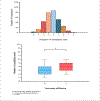Cerebral Edema Monitoring and Management Strategies: Results from an International Practice Survey
- PMID: 39085504
- PMCID: PMC11782636
- DOI: 10.1007/s12028-024-02077-0
Cerebral Edema Monitoring and Management Strategies: Results from an International Practice Survey
Abstract
Background: Cerebral edema is a common, potentially life-threatening complication in critically ill patients with acute brain injury. However, uncertainty remains regarding best monitoring and treatment strategies, which may result in wide practice variations.
Methods: A 20-question digital survey on monitoring and management practices was disseminated between July 2022 and May 2023 to clinicians who manage cerebral edema. The survey was promoted through email, social media, medical conferences, and the Neurocritical Care Society Web site. We used the χ2 test, Fisher's exact test, analysis of variance, and logistic regression to report factors associated with practice variation, diagnostic monitoring methods, and therapeutic triggers based on practitioner and institutional characteristics.
Results: Of 321 participants from 160 institutions in 30 countries, 65% were from university-affiliated centers, 74% were attending physicians, 38% were woman, 38% had neurology training, and 55% were US-based. Eighty-four percent observed practice variations at their institutions, with "provider preference" being cited most (87%). Factors linked to variation included gender, experience, university affiliation, and practicing outside the United States. University affiliates tended to use more tests (median 3.87 vs. 3.43, p = 0.01) to monitor cerebral edema. Regarding management practices, 20% of respondents' preferred timing for decompressive hemicraniectomy was after 48 h, and 37% stated that radiographic findings only would be sufficient to trigger surgery. Fifty percent of respondents reported initiating osmotic therapy based on radiographic indications or prophylactically. There were no significant associations between management strategies and respondent or center characteristics. Twenty-seven percent of respondents indicated that they acquired neuroimaging at intervals of 24 h or less. Within this group, attending physicians were more likely to follow this practice (65.5% vs. 34.5%, p = 0.04).
Conclusions: Cerebral edema monitoring and management strategies vary. Features associated with practice variations include both practitioner and institutional characteristics. We provide a foundation for understanding practice patterns that is crucial for informing educational initiatives, standardizing guidelines, and conducting future trials.
Keywords: Cerebral edema; Decompressive craniectomy; Osmotic therapy; Practice variation.
© 2024. Springer Science+Business Media, LLC, part of Springer Nature and Neurocritical Care Society.
Conflict of interest statement
Conflict of interest: The authors declare that there are no relevant conflicts of interest. Ethical Approval/Informed Consent: The study was exempt from institutional review board approval and was approved by the Neurocritical Care Society Research Committee for distribution among Neurocritical Care Society members. Survey consent clarified that participation was voluntary and that responses are anonymous.
Figures
References
-
- Powers WJ, Rabinstein AA, Ackerson T, et al. Guidelines for the early management of patients with acute ischemic stroke: 2019 update to the 2018 guidelines for the early management of acute ischemic stroke: a Guideline for Healthcare Professionals From the American Heart Association/American Stroke Association. Stroke. 2019;50(12):e344–418. 10.1161/STR.0000000000000211. - DOI - PubMed
-
- Wijdicks EF, Sheth KN, Carter BS, et al. Recommendations for the management of cerebral and cerebellar infarction with swelling: a statement for healthcare professionals from the American Heart Association/American Stroke Association. Stroke. 2014;45(4):1222–38. 10.1161/01.str.0000441965.15164.d6. - DOI - PubMed
MeSH terms
Grants and funding
LinkOut - more resources
Full Text Sources
Medical




